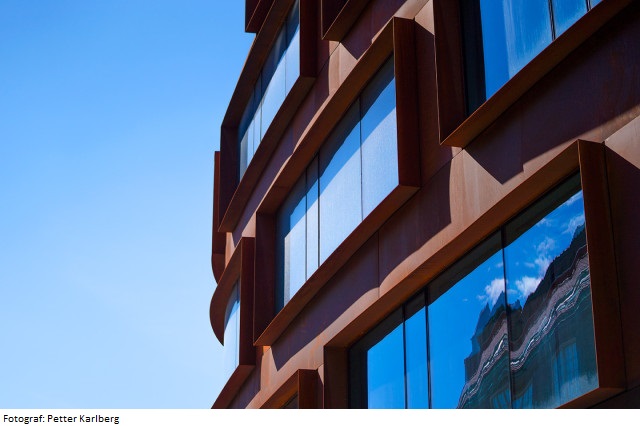We aim at developing a new and sustainable Architecture by investigating the architectural design potential within the principles of Sustainability.
A42H1B Sustainable Design - Studio 4:1 12.0 credits
This course has been discontinued.
Last planned examination: Spring 2022
Decision to discontinue this course:
No information inserted
Content and learning outcomes
Course contents
Intended learning outcomes
Micro - Macro; A) Micro
Overall goals
The project is part of the Sustainable Design Studio.
Studio Description: In order to develop new strategies for designing a sustainable society, this Studio emphazise economy, ecology, energy and new technology in relation to architecture and urban design.
2. The course/project goal is to increase the student's knowledge in this area/field and skills/knowledge in the field of architecture in general. The students will enter the project with varying degrees of knowledge/skills and will subsequently end up at different levels at the end of the course/project.
3. The individual student must show an increase in the particular skills/knowledge offered in the studio and in the field of architecture in general.
Course goals
The Micro-Macro studio sets special focus on the creation of an interdisciplinary working process, building up technical and architectural know-how by investigating materials, processes and details through project work.
The basics of sustainable Architecture are studied in the prototype project (project 4:1 and 5:1), the specific use of sustainability within Architecture is studied in the implementation project (project 4:3)
This project
Sited on an island in the Stockholm Archipelago, the project will be developed around ideas of sustainable living. The studio work will create an architectural understanding for basic principles of sustainability at the same time as the work will relate to Stockholm – environmental capital 2010 and initiatives to save the Baltic Sea.
We will explore basic conceptions like eco-system, climate design, energy flow and tectonics (material/assembly) and we will apply them as design conceptions to develop prototype projects of detailed scale. Input lectures together with partly shared design research will lead to individual architectural projects.
5th year students with completed one year sustainable design studio get the opportunity of individually defining the focus of their investigation
Literature and preparations
Specific prerequisites
Bachelor’s Degree, or an equivalent level, within the field of Architecture.
Recommended prerequisites
Bachelor’s Degree, or an equivalent level, within the field of Architecture.
Equipment
Literature
Recommended reading/handbooks for
Climate Design
1. Climate Design: Solutions for Buildings that Can Do More with Less Technology by Gerhard Hausladen, Michael de Saldanha, Petra Liedl, and Christina Sager
2. Energy Manual: Sustainable Architecture by Manfred Hegger, Matthias Fuchs, Thomas Stark, and Martin Zeumer
3. Sustainability, Ed Melet
4. Smartness, Ed van Hinte
Tectonics
1. Lightness, Ed van Hinte
2. Deplazes: Constructing Architecture,
3. Structures of Jürg Conzett, AA publication
4. Die Unschuld des Betongs, ed Arthur Rüegg
5. Cecil Balmond: Informal
6. Timber engineering – the swiss contribution
Examination and completion
If the course is discontinued, students may request to be examined during the following two academic years.
Grading scale
Examination
- PRO1 - Project part 1, 9.0 credits, grading scale: P, F
- PRO2 - Project part 2, 3.0 credits, grading scale: P, F
Based on recommendation from KTH’s coordinator for disabilities, the examiner will decide how to adapt an examination for students with documented disability.
The examiner may apply another examination format when re-examining individual students.
The course consists of two parts; a fulfilled and delivered project work (9 credits) and a passed final assessment (3 credits). There is at least one intermediate assessment during the course.
Other requirements for final grade
a) Presentation requirements
Delivery of all intermediate and final hand-ins is a requirement for final grade.b) Examination
80% attendance. Active participation in lectures, tutorials, and seminars etc. Passed intermediate and final assessments. Compulsory attendance during the assessment reviews.
Completion: The project work shall be delivered and, if necessary, reworked within the set time limit. See general directions.
(Overall principle: Autumn term projects must be approved during the following Spring term: Spring term projects must be approved before the start of the following Autumn term. The reworked projects must be delivered at least one week before the time limit.)
The project work is to be documented in a portfolio, including drawings, analysis and models. The work process shall be legible.
Opportunity to complete the requirements via supplementary examination
Opportunity to raise an approved grade via renewed examination
Examiner
Ethical approach
- All members of a group are responsible for the group's work.
- In any assessment, every student shall honestly disclose any help received and sources used.
- In an oral assessment, every student shall be able to present and answer questions about the entire assignment and solution.
Further information
Course room in Canvas
Offered by
Main field of study
Education cycle
Add-on studies
Supplementary information
Incoming exchange students within an architecture agreement can select this course.
No other exchange students are allowed to select this course.